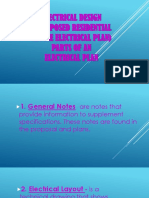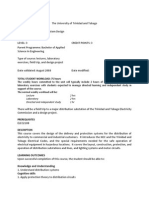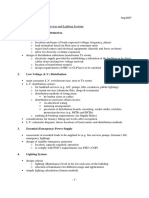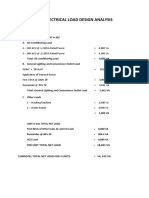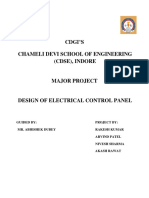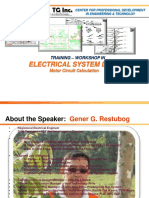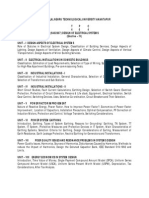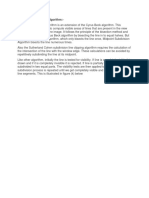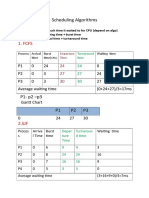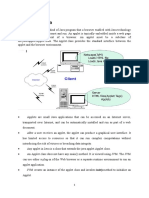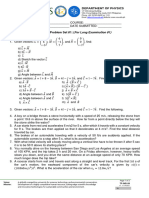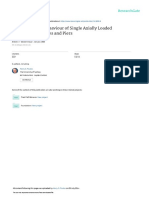EE405 Electrical System Design
EE405 Electrical System Design
Uploaded by
Hari KrishnanCopyright:
Available Formats
EE405 Electrical System Design
EE405 Electrical System Design
Uploaded by
Hari KrishnanOriginal Description:
Copyright
Available Formats
Share this document
Did you find this document useful?
Is this content inappropriate?
Copyright:
Available Formats
EE405 Electrical System Design
EE405 Electrical System Design
Uploaded by
Hari KrishnanCopyright:
Available Formats
KTU/ASST1(ACADEMIC)/3453/2018 (Page : 7)
L-T-P - Year of
Course code Course Name Introduction
Credits
EE405 Electrical System Design 3-1-0-4 2016
Prerequisite: Nil
Course Objectives
To make aware of the Acts and Rules regulating the design of electrical .systems in India.
To impart knowledge in the design of low voltage and medium voltage electrical
installations.
To give basic knowledge of design of distribution transformer substations, their installations
and earthing design for transformer substations
To familiarise lighting calculations and external lighting.
Syllabus
Electrical system design practices – general awareness of IS Codes, Electricity Acts & Rules,
NEC etc. Domestic Installations, Industrial Installations and 11 kV substations. Design features
of Recreational buildings and High-rise building. Selection of Standby generators and their
Installations. Underground cable installations and their accessories. Design features of external
lighting, lightning protection and special requirements for lifts and fire fighting equipments.
Expected outcome
The students will be able to
i. Know the basic Rules and Regulations of electrical systems design.
ii. Design simple electrical systems and prepare the schematic diagram with all the
specifications.
KTU
Text Books
STUDENTS
1. J. B. Gupta, A Course in Electrical Installation Estimating and Costing, S.K. Kataria &
Sons; Reprint 2013 edition (2013).
2. K. B. Raina, S. K. Bhattacharya, Electrical Design Estimating Costing, NEW AGE; Reprint
edition (2010).
3. M. K. Giridharan, Electrical Systems Design, , I K International Publishers, New Delhi, 2nd
edition, 2016
Data Book (Approved for use in the examination):
1. M K Giridharan, Electrical Systems Design Data Hand book, I K International Publishers,
New Delhi, 2011
2. N. Rajendran, Electrical System Design Data Book
References:
1. National Electric Code, Bureau of Indian Standards publications, 2011.
2. Relevant Indian Standard – specifications (IS – 732, IS – 746, IS – 3043, IS – 900), etc.
3. S. L. Uppal, Electrical Wiring Estimating & Costing, Khanna Publishers, 2008
Course Plan
Sem.
Module Contents Hours Exam
Marks
General awareness of IS Codes (IS 3043, IS 732, IS 2675,
IS 5216-P12, IS 2309), The Indian Electricity Act 2003, National
I Electric Code (NEC 2011) - scope and safety aspects applicable to 8 15%
low and medium (domestic) voltage installations, Electric services in
buildings, Classification of voltages, standards and specifications.
For more study materials>www.ktustudents.in
KTU/ASST1(ACADEMIC)/3453/2018 (Page : 8)
General aspects of the design of electrical installations for domestic
dwellings as per NEC guidelines (low and medium voltage
installations)–connected load calculation, sub circuit determination,
II 10 15%
selection of main distribution board, sub distribution board, MCB,
ELCB, MCCB and cables for sub circuits. Pre-commissioning tests
of domestic installations.
FIRST INTERNAL EXAMINATION
Industrial installations –classifications- Design of distribution
systems with light power and motor loads for small and medium
III industries. Selection of transformer substations, switchgears and 10 15%
protective devices – Design of indoor and outdoor 11 kV substations
up to 630 kVA.
Short circuit calculations and Design of earthing for 11 kV substation
IV of capacity up to 630 kVA. Pre-commissioning tests of cables and 8 15%
transformers.
SECOND INTERNAL EXAMINATION
Design of illumination systems – Average lumen method- lighting
design calculations using Coefficient of utilisation (CU) and light
V loss factor (LLF) - classification and selection of luminaires. Exterior 8 20%
lighting design- road lighting and area lighting. Design requirements
for high rise buildings and recreational buildings.
Energy conservation techniques in lighting and power. Selection of
standby generator –power rating - Continuous, prime power and
VI standby power, installation and its protection, Introduction to 10 20%
KTU STUDENTS
Automatic Main Failure (AMF) System. Introduction to Solar PV
systems for domestic applications. Simple design projects.
END SEMESTER EXAMINATION
QUESTION PAPER PATTERN (End semester exam)
Maximum Marks: 100 Exam Duration: 3 Hourrs.
(Approved data handbook to be permitted inside examination hall)
Part A: Eight compulsory questions. One question from each module of Modules I - IV; and
two each from Module V & VI. Student has to answer all questions. (8 x5) = 40
Part B: Three questions uniformly covering Modules I & II. Student has to answer any 2 from
the 3 questions: (2 x 10) = 20. Each question can have maximum of 4 sub questions (a, b, c, d),
if needed.
Part C: Three questions uniformly covering Modules III & IV. Student has to answer any 2
from the 3 questions: (2 x 10) = 20. Each question can have maximum of 4 sub questions (a, b,
c, d), if needed.
Part D: Three questions uniformly covering Modules V & VI. Student has to answer any 2
from the 3 questions: (2 x 10) = 20. Each question can have maximum of 4 sub questions (a, b,
c, d), if needed.
For more study materials>www.ktustudents.in
You might also like
- Matsuura MC-760V2 Electrical DiagramDocument38 pagesMatsuura MC-760V2 Electrical Diagramsunhuynh75% (4)
- Etap Electrical Tutorial PDFDocument2 pagesEtap Electrical Tutorial PDFGary50% (2)
- Assignment 2 (Lighting)Document26 pagesAssignment 2 (Lighting)Hari HaranNo ratings yet
- Electrical Systems Design Based On Pec 2009 PDFDocument2 pagesElectrical Systems Design Based On Pec 2009 PDFLydherson SepnioNo ratings yet
- Practical Guide to International Standardization for Electrical Engineers: Impact on Smart Grid and e-Mobility MarketsFrom EverandPractical Guide to International Standardization for Electrical Engineers: Impact on Smart Grid and e-Mobility MarketsNo ratings yet
- Pitts Model 12 POHDocument21 pagesPitts Model 12 POHKyle TiessenNo ratings yet
- Electrical Design (Proposed Residential House Electrical Plan) Parts of An Electrical PlanDocument18 pagesElectrical Design (Proposed Residential House Electrical Plan) Parts of An Electrical PlanJereemy PaloyoNo ratings yet
- 5 Ee12-Electrical System Design-Lec (Residential) - Lec-2021Document13 pages5 Ee12-Electrical System Design-Lec (Residential) - Lec-2021Silwy OneNo ratings yet
- Ee158 Syllabus 1S1819Document4 pagesEe158 Syllabus 1S1819Emman Joshua BustoNo ratings yet
- Electrical System Design Required For Industry OverviewDocument24 pagesElectrical System Design Required For Industry OverviewNilesh NigadeNo ratings yet
- Load Schedule - EMDPC (RETAIL) PDFDocument5 pagesLoad Schedule - EMDPC (RETAIL) PDFJoshua CabanaNo ratings yet
- ELSD310B Electrical System DesignDocument3 pagesELSD310B Electrical System DesignKendall BirjueNo ratings yet
- Tribhuvan University: Institute of EngineeringDocument10 pagesTribhuvan University: Institute of EngineeringDipak KhadkaNo ratings yet
- Group3 Electrical System DesignDocument8 pagesGroup3 Electrical System DesignChristian AldeNo ratings yet
- Beginners' Electrical Design CourseDocument16 pagesBeginners' Electrical Design CourseSARATHBABU LAKSHMANANNo ratings yet
- An Overview of Short Circuit Current (Part 3) : Sample Calculation For Small LT SystemDocument5 pagesAn Overview of Short Circuit Current (Part 3) : Sample Calculation For Small LT SystemRobert GalarzaNo ratings yet
- Lecture 158Document119 pagesLecture 158Emman Joshua BustoNo ratings yet
- Development and Design of Electrical Infrastructures in Modern CitiesDocument54 pagesDevelopment and Design of Electrical Infrastructures in Modern CitiesPaul AuduNo ratings yet
- Electrical Design EnginnerDocument4 pagesElectrical Design EnginnersivasankarNo ratings yet
- Substation AbstractDocument5 pagesSubstation AbstractHsn PrasadNo ratings yet
- The Following Is A List of Electrical Design Services That We Can ProvideDocument5 pagesThe Following Is A List of Electrical Design Services That We Can ProvidetomptomptopmNo ratings yet
- Electrical DesigningDocument6 pagesElectrical DesigningHarish RNo ratings yet
- Electrical and Lighting System Design (HKU)Document2 pagesElectrical and Lighting System Design (HKU)李梓誠No ratings yet
- Abstract of Indian Electricity RulesDocument3 pagesAbstract of Indian Electricity RulesJignesh ParmarNo ratings yet
- Brochure SIMARIS Software ToolsDocument8 pagesBrochure SIMARIS Software ToolsDavid LovatoNo ratings yet
- CHAPTER NO. 3 - Estimating and Costing of Domestic and Industrial WiringDocument14 pagesCHAPTER NO. 3 - Estimating and Costing of Domestic and Industrial WiringsatyaNo ratings yet
- AED Design Requirements - Electrical Design Requirements - Jul - 11Document30 pagesAED Design Requirements - Electrical Design Requirements - Jul - 11Krishna ManandharNo ratings yet
- BUILDING SERVICES IIQuestion BankDocument37 pagesBUILDING SERVICES IIQuestion BankSiva Raman100% (1)
- Chapter 3 Feeder DesignDocument26 pagesChapter 3 Feeder Designfitwi halefom100% (1)
- Electrical System Design - Lec2 PDFDocument39 pagesElectrical System Design - Lec2 PDFtowiwaNo ratings yet
- Electrical Load Analysis DraftDocument3 pagesElectrical Load Analysis DraftMyrfeiulle4 FreoNo ratings yet
- Electrical Distribution SystemDocument21 pagesElectrical Distribution System31Abhinav AkashNo ratings yet
- Electrical Load Estimation - Part Two Electrical KnowhowDocument1 pageElectrical Load Estimation - Part Two Electrical KnowhowSintayehu TerefeNo ratings yet
- Electrical System SyllabusDocument3 pagesElectrical System SyllabusCADD LEADERNo ratings yet
- Electrical Design and DraftingDocument3 pagesElectrical Design and DraftingMURALINo ratings yet
- Major ProjectDocument30 pagesMajor ProjectRakesh YadavNo ratings yet
- Page 4 - Electrical Layout (Court)Document1 pagePage 4 - Electrical Layout (Court)Jet ToledoNo ratings yet
- Design and Assembly of APFC Electrical PanelDocument4 pagesDesign and Assembly of APFC Electrical PanelqxzyNo ratings yet
- 06 Short Circuit - IECDocument46 pages06 Short Circuit - IECKhaled SalemNo ratings yet
- Topic 6 Electrical Services To BuildingsDocument14 pagesTopic 6 Electrical Services To Buildingsullhan84100% (1)
- Street Lighting Design Guide and Department Standard Specification 6 EditionDocument19 pagesStreet Lighting Design Guide and Department Standard Specification 6 EditionOvidiu Chirvase100% (1)
- Short Circuit Currents and Circuit Breaker SelectionDocument25 pagesShort Circuit Currents and Circuit Breaker Selectionjiguparmar1516No ratings yet
- EE-442 (Electric Energy Utilization)Document2 pagesEE-442 (Electric Energy Utilization)dhineshkm10100% (1)
- Chapter D - MV and LV Architecture Selection GuideDocument36 pagesChapter D - MV and LV Architecture Selection Guidempetrescu80No ratings yet
- Electrical DesignDocument21 pagesElectrical Designomair sirajNo ratings yet
- 400 Volts System By: Engr. Jesus C. Santos: April 6, 2013Document1 page400 Volts System By: Engr. Jesus C. Santos: April 6, 2013stephen dinopolNo ratings yet
- Volt DropDocument1 pageVolt DropMELVINNo ratings yet
- CH 2 Power Sys 010809Document73 pagesCH 2 Power Sys 010809hafiz azmanNo ratings yet
- Electrical Design AnalysisDocument5 pagesElectrical Design AnalysisROMEO GERARD LEVITANo ratings yet
- Electrical System Design - Branch CKTDocument23 pagesElectrical System Design - Branch CKTtowiwaNo ratings yet
- MR - Mentoring EE Educators Towards PEEEngr. Cirilo Calibjo Nov. 27 2015Document74 pagesMR - Mentoring EE Educators Towards PEEEngr. Cirilo Calibjo Nov. 27 2015ramelNo ratings yet
- Voltage Drop PresentatnDocument16 pagesVoltage Drop Presentatnmajortay100% (1)
- Load Schedule - JayDocument28 pagesLoad Schedule - JayGilbertNo ratings yet
- Element D: D5000 Load Calculation CriteriaDocument3 pagesElement D: D5000 Load Calculation CriteriaAnil Singh100% (1)
- Lecture 11 Electrification of Commercial InstallationDocument7 pagesLecture 11 Electrification of Commercial InstallationBUKENYA BEEE-2026No ratings yet
- EE 249 Lecture 0 Orientation PDFDocument6 pagesEE 249 Lecture 0 Orientation PDFOnofre Algara Jr.No ratings yet
- Enclosure Form of SegregationDocument18 pagesEnclosure Form of Segregationkkn1234No ratings yet
- Short Circuit Analysis of 33/11/0.4 KV Distribution System Using ETAPDocument8 pagesShort Circuit Analysis of 33/11/0.4 KV Distribution System Using ETAPEmre MetinNo ratings yet
- Design of Electrical SystemsDocument2 pagesDesign of Electrical SystemsDeva Sravan Kumar SarmaNo ratings yet
- Selective Coordination Breaker Application ChartDocument5 pagesSelective Coordination Breaker Application Charthanner90No ratings yet
- 1248791462midpoint Subdivision AlgorithmDocument3 pages1248791462midpoint Subdivision AlgorithmHari KrishnanNo ratings yet
- Scheduling Algorithms: 1. FcfsDocument6 pagesScheduling Algorithms: 1. FcfsHari KrishnanNo ratings yet
- Applets in JavaDocument13 pagesApplets in JavaHari KrishnanNo ratings yet
- EE403 Distributed Generation and Smart GridsDocument3 pagesEE403 Distributed Generation and Smart GridsHari KrishnanNo ratings yet
- Java - AbstractionDocument7 pagesJava - AbstractionHari KrishnanNo ratings yet
- Time Control Technique: Timer MK 9906N, On Delayed MinitimerDocument4 pagesTime Control Technique: Timer MK 9906N, On Delayed MinitimerKim Hảo Hoàng NguyễnNo ratings yet
- Viscosity of Liquids (1) : Ryan Febriyanto, Irza Rachman S., Safitri Wulansari, Medina YasminDocument5 pagesViscosity of Liquids (1) : Ryan Febriyanto, Irza Rachman S., Safitri Wulansari, Medina YasminSafitri WulansariNo ratings yet
- Crack Windows 2Document2 pagesCrack Windows 2studyuntildieNo ratings yet
- Project ReportDocument46 pagesProject ReportmukulNo ratings yet
- Lecture 4 - Thermal Resistance NetworkDocument14 pagesLecture 4 - Thermal Resistance Networknatnaelzelalem03No ratings yet
- We Can Use SRVCTL To ManageDocument10 pagesWe Can Use SRVCTL To ManageRagin ChittaliyaNo ratings yet
- AE264 Spring2014 HW1Document3 pagesAE264 Spring2014 HW1Serdar BilgeNo ratings yet
- Decoding The Startup File For ARM Cortex M4Document5 pagesDecoding The Startup File For ARM Cortex M4Satish MoorthyNo ratings yet
- FE Lab 1Document23 pagesFE Lab 1patrickNX9420No ratings yet
- Daewoo Ch. Cp-822fDocument48 pagesDaewoo Ch. Cp-822flivionetespanNo ratings yet
- Chew Microwave and Optical Fiber PDFDocument362 pagesChew Microwave and Optical Fiber PDFJoseLuisLagunasNo ratings yet
- Electrical Discharge Machining: HistoryDocument11 pagesElectrical Discharge Machining: HistoryMwafaq Bani Amirah100% (1)
- Problem Set 1Document2 pagesProblem Set 1tamayo.mariella.linnethNo ratings yet
- Duns and Ros (STD)Document10 pagesDuns and Ros (STD)yaqeenadel2002No ratings yet
- Focus On Cycling: Copenhagen Guidelines For The Design of Road ProjectsDocument13 pagesFocus On Cycling: Copenhagen Guidelines For The Design of Road ProjectsHumaning EmpresarialNo ratings yet
- Face Technology PDFDocument495 pagesFace Technology PDFRadhaNo ratings yet
- 8BK30 Catalog PDFDocument22 pages8BK30 Catalog PDFRafael SilvaNo ratings yet
- MaheshKumarDubey (1 3)Document2 pagesMaheshKumarDubey (1 3)BaljeetNo ratings yet
- Poulos - 1967 - The Settlement Behaviour of Single Axially Loaded Incompressible Piles and PiersDocument22 pagesPoulos - 1967 - The Settlement Behaviour of Single Axially Loaded Incompressible Piles and PiersRsiggyNo ratings yet
- PR79975 INR-CWW - BMW Brochure The 3.PDF - Asset.1668495541440Document24 pagesPR79975 INR-CWW - BMW Brochure The 3.PDF - Asset.1668495541440movyagazulaNo ratings yet
- Chapter 4 Database SecurityDocument10 pagesChapter 4 Database SecurityMahendra S. PatilNo ratings yet
- Determination of Invertase Activity by DNS Colorimetric Method and Effects of PH and TemperatureDocument6 pagesDetermination of Invertase Activity by DNS Colorimetric Method and Effects of PH and TemperaturePatricia Camryne AmbidaNo ratings yet
- Schuler Massivumformung Broschuere eDocument74 pagesSchuler Massivumformung Broschuere echidambaram kasiNo ratings yet
- Tutorial 3 SolutionDocument5 pagesTutorial 3 SolutionUmmi Kalthum MohamadNo ratings yet
- Ace 14XW Part BookDocument243 pagesAce 14XW Part Bookasim ghosh100% (1)
- Full Text 01Document68 pagesFull Text 01Mardiyanto GeoNo ratings yet
- Lab07 Object SegmentationDocument31 pagesLab07 Object SegmentationDũng HiNo ratings yet
- Ul18 12Document2 pagesUl18 12kasiiiiiNo ratings yet







